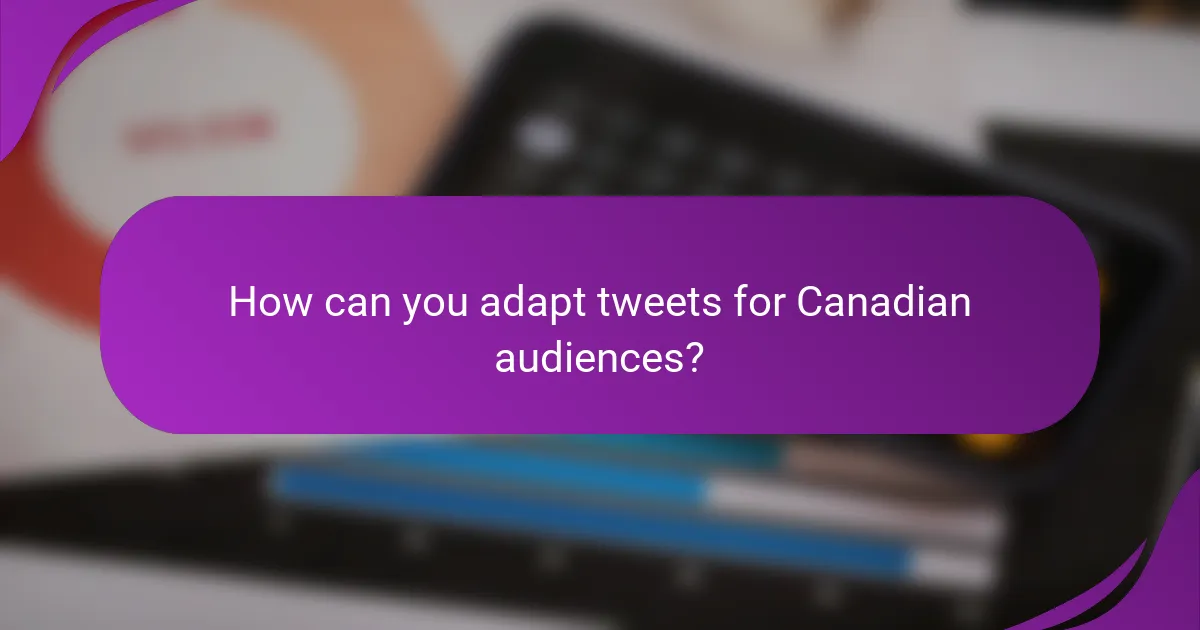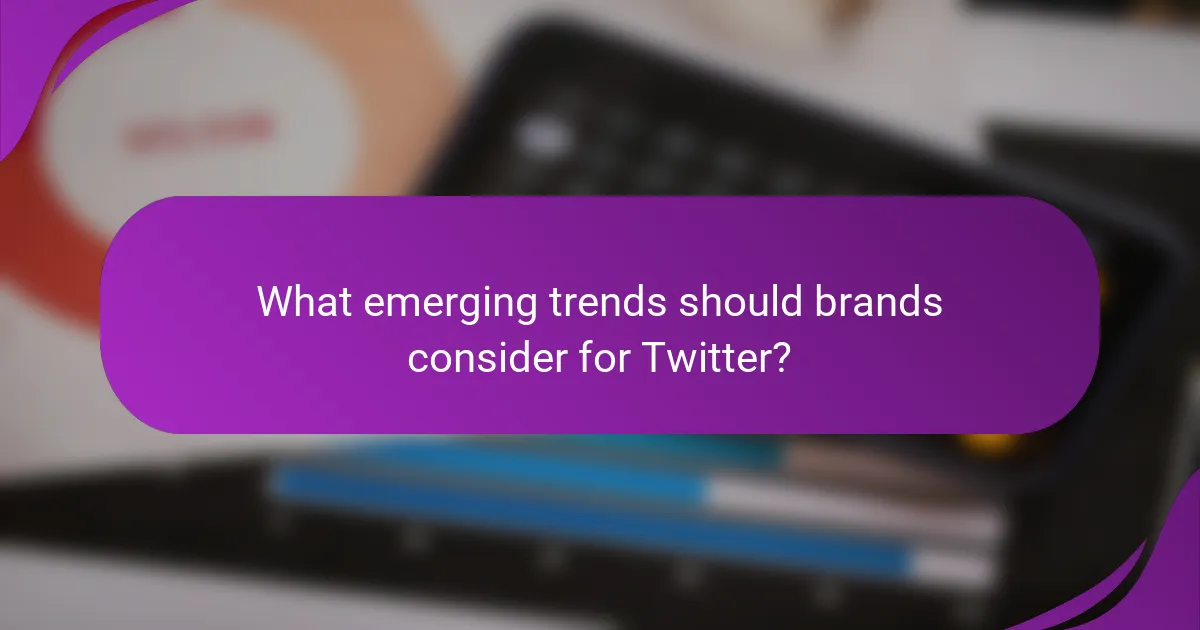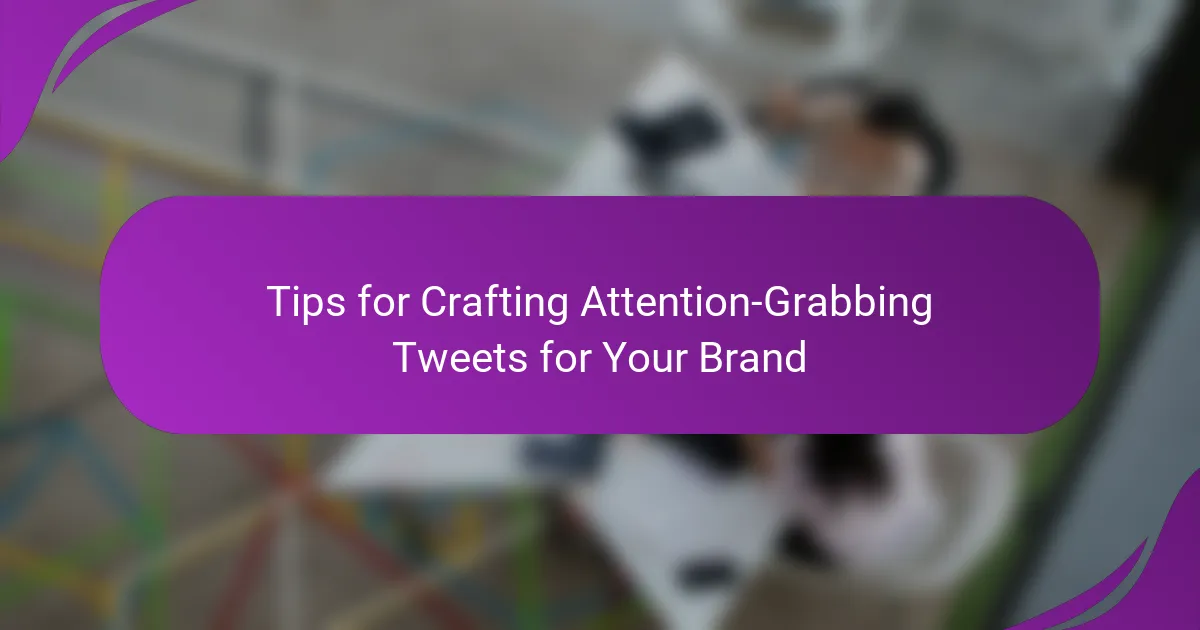Crafting attention-grabbing tweets for your brand requires a blend of clarity, creativity, and connection. Focus on using visuals, trending hashtags, and compelling calls to action to engage your audience effectively. Additionally, keeping your tweets concise and timing them strategically can significantly enhance their impact and visibility.

How can you create engaging tweets for your brand?
To create engaging tweets for your brand, focus on clarity, creativity, and connection. Use visuals, trending hashtags, and compelling calls to action to capture attention and encourage interaction.
Use eye-catching visuals
Incorporating eye-catching visuals in your tweets can significantly boost engagement. Images, GIFs, and videos can convey your message more effectively than text alone, making your content more shareable.
Consider using high-quality images that reflect your brand’s identity. Tools like Canva can help you create visually appealing graphics tailored to your audience.
Incorporate trending hashtags
Using trending hashtags can increase the visibility of your tweets and connect your brand with relevant conversations. Research popular hashtags in your industry and include them strategically in your posts.
Tools like Hashtagify or Twitter’s own search feature can help you identify trending topics. Aim for 1-3 hashtags per tweet to avoid clutter while maximizing reach.
Craft compelling calls to action
Compelling calls to action (CTAs) encourage your audience to engage with your content. Phrases like “retweet if you agree” or “click the link for more” can prompt users to take action.
Make your CTAs clear and direct. Test different wording to see which resonates best with your audience, and adjust based on engagement metrics.
Utilize Twitter polls for engagement
Twitter polls are an effective way to engage your audience and gather feedback. They allow followers to participate in a quick, interactive format that can spark conversations.
Keep your polls simple and relevant to your brand. For example, ask followers about their preferences or opinions on new products or services to foster community involvement.
Share user-generated content
Sharing user-generated content (UGC) can enhance your brand’s credibility and foster a sense of community. Highlighting posts from satisfied customers or fans shows appreciation and encourages others to engage.
Encourage UGC by creating branded hashtags or running contests. Always credit the original creator to build trust and encourage more users to share their experiences with your brand.

What are the best practices for tweet length?
The best practices for tweet length focus on keeping your messages clear and engaging. Aim for brevity while ensuring your content is impactful, as tweets under 280 characters are more likely to resonate with your audience.
Keep tweets under 280 characters
Staying within the 280-character limit is essential for effective tweeting. This constraint encourages clarity and precision, allowing your audience to grasp your message quickly. Shorter tweets often lead to higher engagement rates, as they are easier to read and share.
Consider using tools that count characters as you compose your tweet. This can help you avoid exceeding the limit and ensure your message remains concise. Aim for tweets that are around 100-120 characters to leave room for retweets and comments.
Use concise language
Concise language is crucial for crafting impactful tweets. Use simple words and phrases that convey your message without unnecessary embellishments. This approach not only saves space but also enhances readability.
Avoid jargon and complex terms that may confuse your audience. Instead, opt for straightforward language that resonates with your target demographic. For example, replace “utilize” with “use” and “demonstrate” with “show” to maintain clarity.

How can you leverage timing for tweet visibility?
Timing plays a crucial role in maximizing tweet visibility. By understanding when your audience is most active, you can significantly enhance engagement and reach for your brand’s tweets.
Post during peak engagement hours
Identifying peak engagement hours is essential for effective tweeting. Generally, these hours fall during lunch breaks and early evenings, typically between 11 AM to 1 PM and 5 PM to 7 PM local time. Experiment with different times to find when your specific audience is most responsive.
Consider using analytics tools to track when your followers are online. This data can help you pinpoint optimal posting times, ensuring your tweets reach the maximum number of users.
Utilize scheduling tools like Buffer
Scheduling tools such as Buffer allow you to plan and automate your tweets for optimal timing. These platforms enable you to set specific times for your posts, ensuring consistency and allowing you to focus on content creation rather than real-time posting.
Using a scheduling tool can also help you maintain a steady flow of tweets, even during off-hours. This strategy can be particularly beneficial for brands with a global audience, as it allows you to reach followers in different time zones without being online 24/7.

What tools can enhance your tweeting strategy?
Utilizing the right tools can significantly improve your tweeting strategy by streamlining scheduling, analyzing performance, and optimizing engagement. Tools like Hootsuite and Twitter Analytics provide valuable insights and functionalities to help brands effectively manage their Twitter presence.
Use Hootsuite for scheduling
Hootsuite is a powerful tool that allows brands to schedule tweets in advance, ensuring consistent posting even during off-hours. By planning your content ahead of time, you can maintain a steady flow of communication with your audience, which is crucial for engagement.
To maximize its effectiveness, consider creating a content calendar that outlines your posting schedule. This helps in balancing promotional content with engaging posts, such as polls or questions. Aim to post during peak engagement times, typically in the late morning or early afternoon, depending on your audience’s habits.
Analyze engagement with Twitter Analytics
Twitter Analytics provides essential metrics to evaluate how your tweets are performing. By examining data such as impressions, engagements, and engagement rates, you can identify which types of content resonate most with your audience.
Regularly review your analytics to spot trends and adjust your strategy accordingly. For instance, if you notice that tweets with images receive significantly higher engagement, prioritize visual content in your future posts. Set a routine to check your analytics weekly to stay on top of your performance and make informed decisions.

What metrics should you track for tweet performance?
To effectively gauge tweet performance, focus on metrics like engagement rates, which include retweets, likes, link clicks, and impressions. These indicators reveal how well your content resonates with your audience and can guide future strategies.
Monitor retweets and likes
Retweets and likes are essential metrics that reflect how much your audience appreciates and shares your content. A high number of retweets indicates that your message is resonating and being shared within their networks, while likes show general approval.
To maximize these metrics, create content that is relatable, humorous, or informative. For instance, tweets that include engaging visuals or questions often receive more interaction. Aim for a retweet rate of around 1-3% for effective engagement.
Track link clicks and impressions
Link clicks and impressions provide insight into how many users are engaging with your content beyond just liking or retweeting. Impressions show how many times your tweet was displayed, while link clicks indicate the number of users who took action to learn more.
To enhance these metrics, use compelling calls-to-action and ensure that your links lead to valuable content. A good benchmark is to aim for a click-through rate (CTR) of 1-2% on your tweets. Regularly analyze these numbers to refine your approach and improve audience engagement.

How can you adapt tweets for Canadian audiences?
To effectively adapt tweets for Canadian audiences, it’s essential to understand local preferences, cultural references, and language nuances. Tailoring your content to resonate with Canadians can enhance engagement and brand loyalty.
Incorporate local events and culture
Highlighting local events and cultural elements in your tweets can create a strong connection with Canadian audiences. For example, referencing national holidays like Canada Day or local festivals can make your tweets more relatable.
Consider using hashtags related to local events or trending topics in Canada. This can increase visibility and engagement, as Canadians often participate in discussions surrounding their community and culture.
Use Canadian English and slang
Using Canadian English and incorporating local slang can make your tweets feel more authentic to Canadian audiences. Terms like “eh,” “toque,” and “double-double” resonate well and reflect a shared cultural identity.
Be mindful of spelling differences as well; for instance, use “colour” instead of “color” and “centre” instead of “center.” This attention to detail shows respect for the local language and enhances your brand’s credibility.

What emerging trends should brands consider for Twitter?
Brands should focus on authenticity, interactive content, and video to stand out on Twitter. Engaging with audiences through these trends can significantly enhance visibility and connection.
Embrace video content for higher engagement
Video content is increasingly favored on Twitter, often resulting in higher engagement rates compared to static posts. Incorporating short, eye-catching videos can capture attention quickly, making it essential for brands to utilize this format effectively.
Consider creating videos that are concise, ideally under 30 seconds, to maintain viewer interest. Highlight key messages or product features, and ensure that the content is visually appealing and relevant to your audience.
To maximize impact, include captions since many users watch videos without sound. Regularly analyze engagement metrics to refine your video strategy and adapt to what resonates most with your followers.
